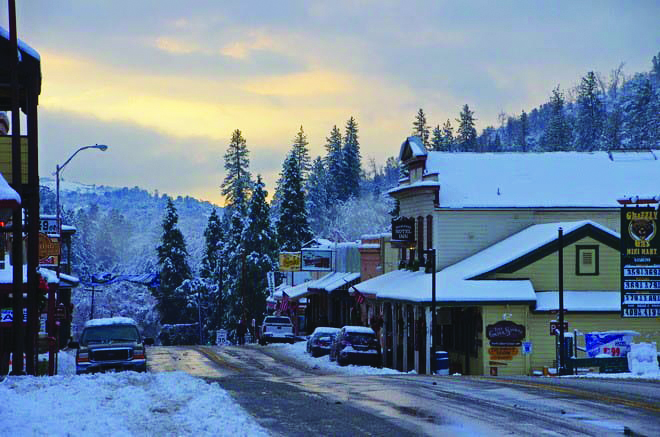
Weather forecasters edging toward instant replay of last year’s weather
The National Weather Service (NWS) recently issued a statement which reads, “There’s a 95% chance of an El Niño occurring between December 2023 and February 2024. In addition, there’s a two-in-three chance it will be a ‘strong’ El Niño.”
Last winter Mariposa County was pummeled by multiple rain storms, causing extensive flooding, demolishing bridges and washing out roadways. The storms were spawned by “atmospheric rivers” and left extensive damage in their wake. Once the torrential rains headed downstream, the entire town of Planada was evacuated, as were parts of the City of Merced as residential and commercial areas sustained flooding as Black Rascal Creek and Bear Creek overflowed.
Those deluges were followed with a days-long snow storm that blanketed the lower elevations of the county, including the town of Mariposa. The upper elevations weren’t simply covered, they were buried. Residents at the 3,000-foot elevation experience two and a half to three feet of heavy, wet snow. The moisture-rich snow snapped heavy tree limbs and left thousands without power or the ability to travel for days.
Several local construction companies and individuals with equipment like skid steers went door to door, plowing out access to homes for a small fee. Many residents were snowed-in for extended periods of time.
According to ABC 30 TV in Fresno, 72 structures sustained damage and 13 were destroyed. Roughly 74% of the impacted homes were not insured.
The Federal Emergency Management Agency (FEMA) was on had accepting and processing claims throughout the summer months.
Many old timers could be heard saying “this is what winters used to be like around here.”
Mariposa County Public Works Department was stretched thin trying to keep the major county asphalt arteries passable, which CalTrans pushed snow off both state highways intersecting in Mariposa.
Public Works Director Shannon Hansen is working proactively in anticipation of another substantial snowfall event.
“The Public Works Department is in the process of introducing a comprehensive snow removal policy that serves multiple purposes. Firstly, it will educate the public about their responsibilities and role during snow removal operations, shedding light on county-wide priorities and the decision-making process of the Public Works Department. Additionally, it aims to provide valuable insights into snow removal from the perspective of the operators themselves,” Hansen explained.
“To enhance our operational capabilities, we are actively working to expand our workforce by hiring two additional employees for each area, enabling us to operate snow removal equipment more effectively. If anyone is interested in applying with the county, they can visit our webpage,” she added.
Like most private business concerns and public agencies, Mariposa County is struggling to fill positions.
“Furthermore, we are dedicated to improving snow removal operations through equipment upgrades, including the acquisition of two graders, a mid-sized excavator, and new snowplows to strengthen our fleet. We are procuring two rotary snowblowers that can be quickly deployed to areas when needed.
“Efforts are also underway to acquire specialized equipment for maintaining culverts and drainage systems, facilitating the free flow of rainwater and snowmelt.
“The Fleet Division is diligently engaged in preventative maintenance measures to ensure that all equipment remains in optimal working condition.
“Also, to address potential workload surges, we have established an active contractors list, providing the Department of Public Works with the capability to swiftly engage external contractors if the Roads Division faces overwhelming demands.
“In the interest of public safety, particularly during heavy snow loads on trees, the Roads Division has also contracted with a specialized tree removal service to address specified ‘hazard’ trees. This initiative aims to mitigate potential risks and enhance public safety during adverse weather conditions.
“These proactive measures underscore our commitment to ensuring the safety and well-being of our community during winter weather challenges. By introducing a comprehensive snow removal policy, expanding our workforce, and investing in cutting-edge equipment and maintenance, we are better prepared to tackle snow and ice-related issues efficiently and effectively.
“Our dedication to these initiatives reflects our unwavering commitment to providing essential services, maintaining vital infrastructure, and safeguarding the public. Together, with the support and cooperation of our community, we look forward to a safer and more resilient winter season ahead,” the Public Works Director stated.
According to a story on GVWire.com, the California Coastal Commission has updated its webpage at www.coastal.ca.gov with El Niño information and resources. Commission staffers say they want residents to click on the link to learn the vital information.
“This is a harbinger that is really scary,” said Donne Brownsey, chair of the California Coastal Commission.
The commission’s website states, “Current ocean conditions are consistent with an emerging El Niño event, while climate model projections indicate a high probability that a strong El Niño will form and continue through the 2023-24 Northern Hemisphere winter, possibly extending through spring. The peak influence of this El Niño event is anticipated for the December-February period, when it could result in more frequent and intense storms, rainfall, and high wave conditions on the California coast.”
The National Oceanic and Atmospheric Administration (NOAA) classifies an El Niño when Pacific Ocean temperatures near the equator rise 0.5 degrees Celsius above average for a month or longer, with expectations of persistence. This oceanic anomaly influences global weather patterns, particularly during the cooler months when its effects are strongest.
The possibility of an El Niño event next winter could significantly impact weather conditions in California and the Western United States, though a variety of factors must be considered.
Strong El Niño events have been forecast in the recent past, but none materialized like last winter’s drought-buster.
According to the NWS, El Nino’s influence on the U.S. is weak during the summer and more pronounced starting in the late fall through spring. By winter, there is an 84% chance of greater than a moderate strength El Niño, and a 56% chance of a strong El Niño developing. Typically, moderate to strong El Niño conditions during the fall and winter result in wetter-than-average conditions from southern California to along the Gulf Coast and drier-than-average conditions in the Pacific Northwest and Ohio Valley. El Nino winters also bring better chances for warmer-than-average temperatures across the northern tier of the country.
A single El Niño event will not result in all of these impacts, but El Niño increases the odds of them occurring.
Finally, while the chance of increased rainfall across California and the Southwest in 2023-2024 has risen due to the expected El Niño, it does not guarantee a wet winter and spring, as historical data shows varying outcomes in past events.
















